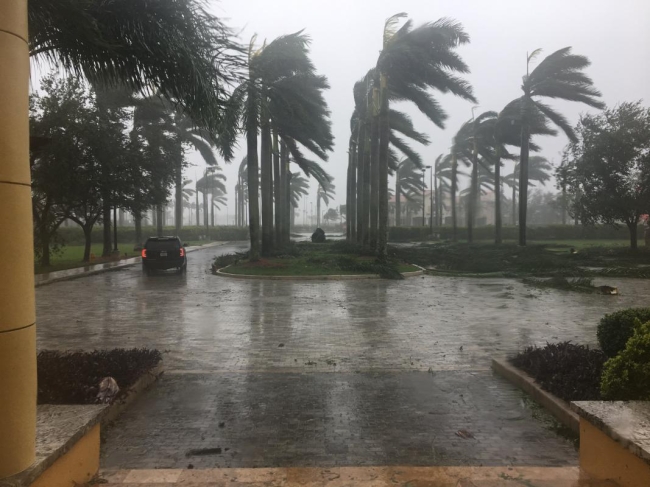You have /5 articles left.
Sign up for a free account or log in.

The campus of Florida International University after Hurricane Irma in 2017. As Hurricane Ian approaches five years later, colleges in its path are preparing for the worst.
Florida International University
As Hurricane Ian approached Florida’s west coast Tuesday, prompting thousands of residents to evacuate, a wave of colleges and universities canceled classes, shut down campuses and evacuated residence halls. The announcements came throughout Monday and Tuesday as the storm’s path and severity became clearer after it made landfall in Cuba, sending students and staff scrambling to prepare.
As of Tuesday, 31 public colleges and dozens of private institutions in the Sunshine State—including the University of Florida, Florida A&M University and the College of Central Florida—had announced they were closing their campuses for part or all of the rest of this week to prepare for the hurricane, which was expected to grow to a category four by landfall.
Storm preparation has transformed campuses and schedules as the fall semester gets underway. Florida State University delayed its homecoming week until next year. Florida A&M plans to close its dining halls and retail locations and will distribute boxed meals to students who remain on campus. The University of Tampa, directly in Ian’s projected path, was a veritable ghost town by Tuesday evening, having bused all students off campus and boarded up its windows.
Some institutions, like the University of Central Florida, canceled all activities but are keeping their housing open so students can weather the storm on campus. Others, like Rollins College in Winter Park, announced they would close residence halls Wednesday and asked students to leave campus—a decision college administrators said they made with “the utmost gravity.”
Students unable to go home are scrambling for alternatives. At Rollins, they will be directed to a local shelter until it’s deemed safe to return to campus.
“Students submit to us their hurricane evacuation plans, which consist of where they plan to ride out the storm. For those students who need shelter, we provide transportation to a local shelter,” Lauren Bradley, Rollins’s assistant vice president for communications, wrote in an email to Inside Higher Ed. “We have not yet said when students should return to campus, as that will be dependent on the damage assessment following the storm.”
Whether institutions keep dorms open or not, students in the state—often in consultation with their parents—are grappling with whether to hunker down on campus or risk driving home in quickening wind speeds and heavy rain.
Robert Verchick, a legal scholar specializing in environmental disaster and the author of the forthcoming book The Octopus in the Parking Garage: A Call for Climate Resilience (Columbia University Press, 2023), said the potential for confusion and panic from parents is one reason colleges and universities in particular should develop robust disaster-response plans.
“It makes sense [to shut down campus] because you have workers and you’ve got all kinds of people you’re responsible for. But if you close a dorm, where are the students going to go?” he said. “Universities are unique in a lot of ways, mainly in that they’re in charge of young adults. They have a special charge to protect their students.”
Naim Kapucu, the author of a 2013 study, “Disaster Resiliency and Culture of Preparedness for University and College Campuses,” said universities should act as quickly as possible to give students and staff a chance to make considered choices and be as prepared as possible for any scenario.
“Early decision [making] and communicating to the impacted campus community members are key,” he wrote in an email to Inside Higher Ed. “There is a delicate balance between panic and complacency in response to disasters.”
Battening Down the Hatches
Kapucu, a professor of public administration and policy at the University of Central Florida, said UCF has a “strong emergency management program” thanks in part to a federal grant of over half a million dollars it received in 2009 to bolster its disaster resilience. Kapucu said the grant allowed UCF to become “the first storm-ready campus in the nation with a fully staffed Emergency Operation Center.”
“I can definitely say that the university is well prepared for hurricanes and other potential human-caused or natural hazards and disasters,” Kapucu wrote. “[I’m] happy to see the university, as one of the largest campuses in the U.S., take [the] potential impact of disasters seriously.”
Some of the institutions in Ian’s path have weathered severe storms before, including Hurricane Irma in 2017. Others, like the University of South Florida in Tampa, have yet to experience a major hurricane. Thanks to climate change, Verchick said, even institutions that haven’t historically been vulnerable to storm surges may have to prepare for more intense and frequent disasters.
“That means more buildings on pilings in coastal areas; it could mean more universities working toward energy independence, so they don’t have to rely on power grids that could go out in an emergency,” he said. “Certainly, the days of special library collections in basements are coming to an end.”
Verchick is no stranger to storm damage. He moved to Louisiana for a faculty position at Loyola University New Orleans just nine months before Hurricane Katrina hit in August 2005; the law school there, where he’s taught ever since, was among the first higher education programs in the city to resume that fall after the storm, relocating in-person classes to Houston.
Witnessing Katrina’s damage firsthand inspired Verchick to dedicate his career to studying climate resiliency. For college campuses and public infrastructure alike, he said, resiliency is almost synonymous with flexibility.
“The one thing that we now know is that the past is not an indicator of what the future weather patterns and climate patterns are going to look like. We know which direction the trend is: we know sea levels are going up, temperatures are getting warmer, storms are getting weirder. But there’s actually a lot that we don’t know,” he said. “So if you’re going to build infrastructure, or if you’re running a university, whatever you’re doing, do it in a way that’s flexible so that you don’t lock yourself into assumptions that might not be true 20 years from now.”
Whether the threats are hurricanes, earthquakes or tornadoes, Verchick said resilience planning is particularly important for colleges and universities across the country because they operate like formally organized communities.
“They’re major employers with workers’ safety to consider, landlords with property value considerations, businesses who lose money when shut down,” he said. “A lot of campuses are basically like little cities.”
Kapucu said that developing long-term strategies to prepare campuses for climate disasters like megastorms is only becoming more important, but that most institutions have been largely focused on short-term preparation.
“We observe more emphasis on immediate response to disasters rather than long-term recovery and investing in resilience. Response to one [disaster], for instance, might not be [an] effective response to another one,” Kapucu wrote. “Thus, developing long-term investment (resilience capacity, resilience building) in preparing campus communities for a range of different disasters is critical.”
Included in that long-term planning, Verchick said, should be strategies for community collaboration in the face of danger.
“This is a learning opportunity, and universities have a special power to inculcate good social lessons in students,” Verchick said. “One lesson for the future is going to be community resilience, which means understanding ahead of time what your vulnerabilities and needs are and what the vulnerabilities and needs of people around you are, then being able to plan and act with those things in mind and take care of one another.”
“These are scary events, Hurricane Ian and others like it,” he continued. “But they are also moments ripe for colleges to model what community resilience can look like.”





